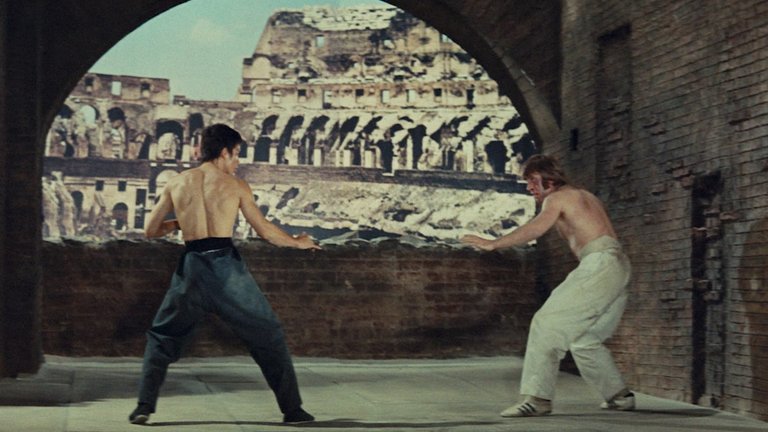Film Review: The Way of the Dragon (1972)

Even within the tragically truncated filmography of Bruce Lee, a handful of his works stand out not merely as vehicles for his martial prowess but as expressions of his artistic vision. Among these, The Way of the Dragon (1972) emerges as the most authentically his film. This action-comedy, his penultimate completed project and the final one released during his lifetime, marks Lee’s debut as director, screenwriter, and producer—a trifecta of roles that underscores his creative ambition. Yet this very authenticity, while granting the film a unique vitality, also exposes its unevenness. The Way of the Dragon is a deeply personal work that oscillates between brilliance and naivety, a testament to Lee’s genius and a reminder of the limits of his inexperience behind the camera.
The plot, by design, is disarmingly straightforward. Set in Rome, it follows Cheng Ching-hua (Nora Miao), a young woman managing a family restaurant with her uncle Wang (Huang Tsun-hing). Their peaceful existence is shattered by local gangsters, led by the predatory boss (Jon Benn), who seeks to intimidate them into selling their property. Cheng’s plea for help to her Hong Kong relatives results in the arrival of Tang Lung (Lee), a stoic martial arts savant dispatched to protect the business. Tang’s initial culture shock—reacting to Rome’s eccentricities with deadpan bewilderment—gives way to a series of escalating confrontations. He trains the staff in self-defense and dismantles the gang’s operations, prompting the villain to hire two lethal specialists: the Japanese karateka (Hwang In-shik) and the American karate champion Colt (Chuck Norris). This setup, though formulaic, serves as a scaffold for Lee’s deeper exploration of cultural identity and physical philosophy.
Lee’s transition from performer to auteur is both inspiring and uneven. Determined to master his new role, he devoured directing manuals and collaborated with producer Raymond Chow, the architect of Golden Harvest’s success. Lee choreographed the fight sequences, supervised dubbing, and wrote the script—a Herculean workload that inevitably diluted his focus. His writing, while intentionally lighter in tone than Fist of Fury (1972), struggles to balance comedy and drama. The narrative’s tonal shifts—veering from slapstick to brutality—reflect a lack of editorial discipline, yet Lee’s refusal to adhere to genre conventions reveals his creative restlessness. This duality—visionary ambition clashing with rookie missteps—defines the film’s character.
The opening third, devoid of martial spectacle, is a showcase for Lee’s underrated comedic timing. As Tang Lung, he embodies the “fish out of water” archetype with charm, dealing with Rome’s quirks—from a long wait at the airport to a hilariously awkward encounter with an Italian prostitute (Malisa Longo, whose brief nudity nods to the era’s exploitation demands). These scenes, steeped in cultural juxtaposition, highlight Lee’s ability to humanise his stoic persona. The humour, though broad, feels organic, offering a refreshing contrast to the grimness of his earlier films. Yet this idiosyncratic approach comes at a cost: the middle act sags under repetitive skirmishes with nameless henchmen, their defeats lacking the visceral thrill of Lee’s later work.
The film’s final act, however, plunges into uncharacteristic darkness. A sudden betrayal by Uncle Wang—a reprise of Huang Tsun-hing’s duplicitous role in Fist of Fury—ignites a bloodbath that feels tonally jarring. Though the body count remains modest by Lee’s standards, the emotional brutality of the scene—literal backstabbing of Cheng’s allies—casts a pall over the victory. Tang Lung’s triumph over the gangsters, culminating in a duel with Colt, is overshadowed by the film’s sour denouement. This abrupt shift from comedy to carnage reveals Lee’s growing desire to infuse martial arts cinema with moral complexity, yet the execution feels unmoored, as if the film itself cannot reconcile its dual identities.
Where The Way of the Dragon ascends to greatness is in its climactic showdown at the Colosseum—a sequence that transcends its narrative flaws. Filmed guerrilla-style on location, the duel between Tang Lung and Colt (Norris, then an up-and-coming fighter) is a symphony of contrasting styles: Lee’s jeet kune do against Norris’s karate precision. The Colosseum’s history as a site of gladiatorial combat lends the fight a mythic resonance, while Lee’s direction—tense, unadorned, and kinetic—captures every strike and counter with visceral clarity. This 10-minute tour de force, arguably the finest fight scene in cinema history, is both a technical marvel and a cultural milestone. It solidified Norris’s Hollywood prospects and immortalised the real-life friendship between the two legends, whose chemistry elevates the confrontation from spectacle to art.
Despite its imperfections, The Way of the Dragon remains a landmark achievement. Produced on a shoestring budget, it was the first major Hong Kong film shot in Europe, breaking geographical and cultural barriers for the industry. Its box office triumph cemented Lee’s status as a global icon, bridging East and West with a universal language of action. The film’s appeal extends beyond martial arts enthusiasts, offering a blend of humor, philosophy, and spectacle that feels surprisingly accessible. Yet for all its entertainment value, it carries a haunting subtext: a glimpse of what Lee might have achieved had his life not been cut short.
RATING: 6/10 (++)
Blog in Croatian https://draxblog.com
Blog in English https://draxreview.wordpress.com/
InLeo blog https://inleo.io/@drax.leo
LeoDex: https://leodex.io/?ref=drax
Hiveonboard: https://hiveonboard.com?ref=drax
InLeo: https://inleo.io/signup?referral=drax.leo
Rising Star game: https://www.risingstargame.com?referrer=drax
1Inch: https://1inch.exchange/#/r/0x83823d8CCB74F828148258BB4457642124b1328e
BTC donations: 1EWxiMiP6iiG9rger3NuUSd6HByaxQWafG
ETH donations: 0xB305F144323b99e6f8b1d66f5D7DE78B498C32A7
BCH donations: qpvxw0jax79lhmvlgcldkzpqanf03r9cjv8y6gtmk9